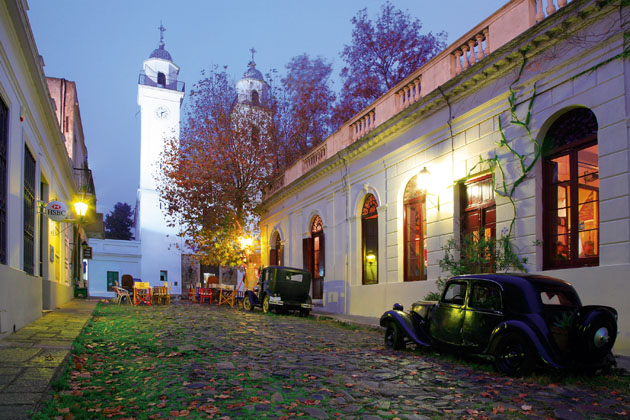Last taste of salt
The sailor’s last taste of salt air is at Piriapolis, an Edwardian seaside resort named for its founder, Señor Piria. On first acquaintance the place seemed quaint and pleasant, but it was while anchored here that we came to understand why Uruguay is not a sailing nation: essentially, the whole coast is a potential lee shore. During one fortnight we endured two westerly blows, and we passed one very exciting day and night with our bow plunging in and out of the waves.
There’s a marina at Piriapolis, which was built for the benefit of foreign yachtsmen, but marinas cost money and we reasoned that “if things get really bad we can always slip inside at the last moment”.
By the time we’d decided that we ought to take refuge it was too late. Fooling about with the anchor while the bow was performing like a fairground ride would have been asking for trouble; and so we just had to hang in there and hope that our Bruce anchor would do the same. It’s amazing how foolish a bunch of well-seasoned mariners can be.
Moving upstream you come to Montevideo and beyond the city various small creeks, of which Riachuelo is renowned as the most scenic. Then, almost at the head of the estuary, you reach Colonia del Sacramento.
Colonia is quite the most attractive town on the River Plate. Being old and scenic, with quaint houses, antique cars, a lighthouse and a half-ruinous citadel wall, it is very popular with sightseers, but unlike Punta or Piriapolis it is also big enough to cope with this influx and yet retain an identity as something more than a tourist town.
With its pleasure port hidden behind a point, it also offers better shelter than the other two – but this is not saying much. While we were anchored here another pampero came through, causing us a certain amount of anxiety.
Across to Argentina
From Colonia we crossed the river to Argentina and the port of Ensenada de La Plata. Here, you can drop the hook in the placid, but very miry waters of a man-made ditch, off the Club de Regatas. Ensenada is also home to three commercial wharves, a nearly finished container port, the navy and a shipyard that turns out huge bulkers. So it’s not exactly scenic or tranquil, and there’s not a lot of space.
Ashore, is a small settlement that is more reminiscent of a seedy Brazilian township than anything seen on the genteel shores of Uruguay. The pavements are cracked, litter bowls along in the gutter, and as for the traffic . . . When you stand on the kerb in Uruguay, all the traffic comes to a polite halt. Try the same on this side of the river and you risk being run down.
The Argentinian side of the Plate is much more polluted and the river banks are lined with plastic bottles. The locals don’t seem to mind this – indeed, they don’t appear to notice it – but when we weighed anchor in Ensenada we brought up 17 plastic bags, several plastic bottles, one boot, a bra, an entire car bumper and a small tree.
Next stop, Buenos Aires – and here we found something to write home about. First, there’s the metropolis itself. A grid-plan city of slim tower blocks, broad avenidas and narrow streets lined with leafy plane trees, in some respects it has a Little London feel to it. But the city is only half the discovery. Famous for its hospitality, the Yacht Club of Argentina offers foreign visitors one week’s free berthing.







